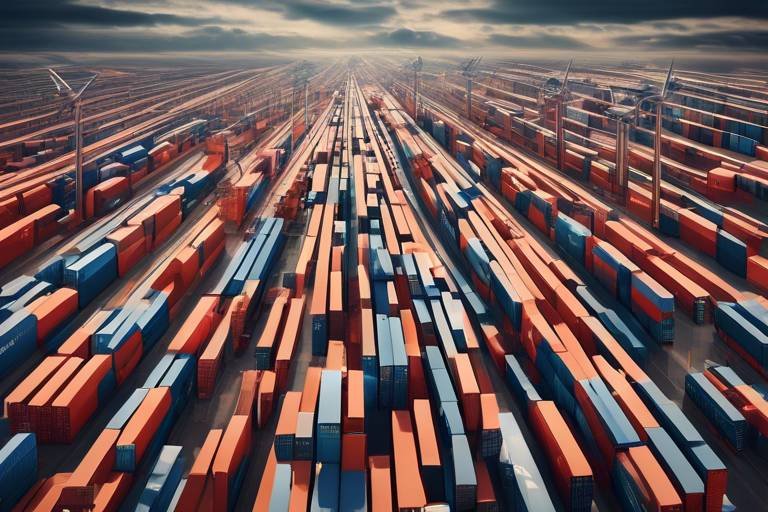How Technology is Reshaping Supply Chain Management
In today's fast-paced world, technology is not just a tool; it's a game changer, especially in the realm of Supply Chain Management (SCM). The evolution of technology has brought about a seismic shift in how businesses operate, manage, and optimize their supply chains. Imagine a vast network of suppliers, manufacturers, and distributors working in perfect harmony, all thanks to cutting-edge technology. This article dives deep into the transformative impact of technology on supply chain management, highlighting innovations, trends, and strategies that enhance efficiency, transparency, and responsiveness in the global marketplace.
From automation to data analytics, the tools at our disposal today are reshaping the way we think about supply chains. No longer are we confined to traditional methods that rely heavily on human input and guesswork. Instead, we are entering an era where machines and algorithms take the lead, making decisions based on real-time data and predictive models. This shift not only improves operational efficiency but also enhances the ability to respond to market changes swiftly. So, how exactly is technology redefining the supply chain landscape? Let’s explore this fascinating transformation.
Automation is revolutionizing supply chains by streamlining processes, reducing human error, and increasing operational efficiency. Picture a well-oiled machine where every part works seamlessly together; that's what automation brings to the table. Technologies such as robotics, automated guided vehicles (AGVs), and warehouse management systems are at the forefront of this transformation. Businesses that embrace automation are not just keeping up; they are setting the pace for their competitors.
For instance, automated systems can handle repetitive tasks like inventory management and order processing with precision, allowing human workers to focus on more strategic initiatives. This leads to quicker turnaround times and improved accuracy. Moreover, automation can significantly cut costs by minimizing waste and optimizing resource allocation. But the implications of automation go beyond just efficiency; they also pave the way for a more agile supply chain capable of adapting to market fluctuations.
Data analytics is the backbone of modern supply chain management. With the right tools, companies can glean insights from vast amounts of data, leading to informed decision-making. Imagine trying to find a needle in a haystack; that’s what managing a supply chain feels like without data analytics. By analyzing performance metrics, businesses can identify inefficiencies, forecast demand, and make strategic adjustments.
Predictive analytics helps businesses anticipate customer demand, optimizing inventory levels and reducing waste. By leveraging historical data and market trends, companies can forecast future demand with remarkable accuracy. This proactive approach not only enhances customer satisfaction but also minimizes the risk of overstocking or stockouts. The methodologies used in predictive analytics can vary, but they all aim to provide a clearer picture of what lies ahead.
Machine learning algorithms enhance demand forecasting accuracy by identifying patterns in historical data. Think of these algorithms as detectives piecing together clues to solve a mystery. They analyze past sales data, seasonal trends, and even social media sentiment to predict future demand. The result? Businesses can respond faster to shifts in consumer behavior, ensuring they have the right products available at the right time.
Real-time data tracking facilitates immediate adjustments to supply chain operations. With technologies like RFID and GPS, companies can monitor their assets and inventory in real time. This level of visibility allows for quick decision-making, reducing delays and improving overall efficiency. Imagine being able to see every step of your product's journey from supplier to consumer; that’s the power of real-time data.
Blockchain technology offers enhanced transparency and security in supply chains. By providing a decentralized ledger, blockchain allows all stakeholders to access the same information, fostering trust and accountability. This is particularly important in industries where traceability is crucial, such as food and pharmaceuticals. Blockchain can improve traceability by ensuring that every transaction is recorded and verifiable, making it easier to track products from origin to consumer.
The Internet of Things (IoT) connects devices and systems, providing valuable data for supply chain optimization. Think of IoT as a web of interconnected devices that communicate with one another. This integration allows for smarter decision-making and improved operational efficiency. However, while the benefits are substantial, there are challenges to consider, such as data security and the need for robust infrastructure.
Smart warehousing solutions leverage IoT technology to automate inventory management and enhance operational efficiency. These solutions can include automated picking systems, drone deliveries, and real-time inventory tracking. By utilizing IoT, warehouses can operate more efficiently, reducing labor costs and increasing throughput. Imagine a warehouse where robots work alongside humans to fulfill orders at lightning speed; that’s the future of smart warehousing.
Technology plays a crucial role in building supply chain resilience against disruptions. In a world where unexpected events can halt operations, having a flexible and adaptable supply chain is more important than ever. By employing technologies such as AI and machine learning, businesses can develop strategies that allow them to pivot quickly in response to challenges. This resilience not only protects the business but also enhances customer trust and loyalty.
- What is the biggest benefit of automation in supply chains? Automation significantly increases operational efficiency and reduces human error, leading to cost savings and faster turnaround times.
- How does data analytics improve supply chain management? Data analytics provides insights into performance metrics, helping businesses make informed decisions and optimize their operations.
- What role does blockchain play in supply chains? Blockchain enhances transparency and security, allowing for better traceability and trust among stakeholders.
- What are smart warehousing solutions? Smart warehousing solutions use IoT technology to automate inventory management and improve operational efficiency.
- How can technology enhance supply chain resilience? Technology helps businesses develop flexible strategies that can quickly adapt to disruptions, ensuring continuity and reliability.

The Role of Automation in Supply Chains
In today's fast-paced world, automation is not just a buzzword; it's a game-changer in the realm of supply chain management. Imagine a well-oiled machine where every cog turns seamlessly, reducing delays and enhancing productivity. That's what automation brings to the table. It streamlines processes, minimizes human error, and boosts operational efficiency, allowing businesses to focus on what truly matters: growth and customer satisfaction.
One of the most significant advantages of automation is its ability to handle repetitive tasks with precision. For instance, consider the order fulfillment process. Traditionally, this involved numerous manual steps, from picking to packing to shipping. With automation, these steps can be executed by robotic systems that work tirelessly, ensuring faster turnaround times and higher accuracy. This not only speeds up the supply chain but also frees up human resources to tackle more complex challenges that require critical thinking and creativity.
Moreover, automation tools are equipped with advanced technologies such as Artificial Intelligence (AI) and Machine Learning (ML). These technologies analyze vast amounts of data to identify inefficiencies and suggest improvements. For example, a warehouse management system can predict when stock levels will run low and automatically reorder supplies, preventing stockouts and ensuring that customers always find what they need.
Another fascinating aspect of automation is its impact on inventory management. By utilizing automated inventory systems, companies can achieve real-time visibility of their stock levels. This transparency allows for better decision-making and enhances the overall responsiveness of the supply chain. Imagine knowing exactly how much product you have at any given moment, which can significantly reduce the risk of overstocking or understocking.
However, the journey to automation isn't without its challenges. Companies must invest in the right technologies and training to ensure a smooth transition. The upfront costs can be daunting, but the long-term savings and efficiency gains often outweigh these initial investments. Businesses need to weigh the pros and cons carefully, but many find that the benefits of automation far exceed the challenges.
To summarize, automation is revolutionizing supply chains by:
- Streamlining processes and reducing human error.
- Enhancing operational efficiency through the use of AI and ML.
- Providing real-time visibility for better inventory management.
- Freeing up human resources for more complex tasks.
As we look to the future, the role of automation in supply chains will only continue to grow. Companies that embrace these technologies will not only improve their operational efficiencies but also gain a competitive edge in an increasingly complex and demanding marketplace.
- What is automation in supply chain management? Automation involves using technology to perform tasks that were previously done by humans, enhancing efficiency and accuracy.
- How does automation improve inventory management? Automated systems provide real-time data on stock levels, helping businesses make informed decisions about reordering and reducing waste.
- What are the challenges of implementing automation? Initial costs, the need for employee training, and integration with existing systems can pose challenges for businesses looking to automate.

Data Analytics for Informed Decision-Making
In today's fast-paced business environment, data analytics has emerged as a game-changer for supply chain management. Companies are no longer operating in a vacuum; instead, they are harnessing the power of data to drive critical decisions. The ability to analyze vast amounts of data enables organizations to gain insights into their supply chain performance, identify bottlenecks, and uncover opportunities for improvement. But how exactly does this work? Well, let’s dive into the fascinating world of data analytics.
At its core, data analytics involves the systematic computational analysis of data. For supply chains, this can mean anything from understanding customer buying patterns to optimizing logistics routes. Companies are leveraging various tools and techniques to extract actionable insights from their data. Some of the most common methods include:
- Descriptive Analytics: This provides a clear picture of what has happened in the past. By analyzing historical data, businesses can identify trends and patterns that inform future strategies.
- Diagnostic Analytics: Going a step further, diagnostic analytics helps determine why something happened. This can be crucial for pinpointing the causes of supply chain disruptions.
- Prescriptive Analytics: This is where the magic happens! Prescriptive analytics offers recommendations on what actions to take based on predictive models.
One of the standout features of data analytics is its ability to facilitate informed decision-making. Imagine a scenario where a company faces a sudden spike in demand for a product. Without data analytics, the company might scramble to respond, potentially leading to stockouts or overproduction. However, with real-time data at their fingertips, decision-makers can quickly assess inventory levels, supplier capabilities, and shipping times to make informed choices. This not only enhances efficiency but also boosts customer satisfaction.
Moreover, the integration of data analytics into supply chain management can lead to significant cost savings. For instance, by analyzing shipping routes and delivery times, companies can optimize their logistics, reducing transportation costs. A recent study showed that organizations that implemented analytics-driven supply chain strategies experienced a 15% reduction in logistics costs on average. This is a clear testament to the power of data in driving operational efficiency.
Another critical aspect is the role of collaboration in data analytics. When multiple stakeholders—suppliers, manufacturers, and retailers—share data insights, the entire supply chain becomes more cohesive. This shared visibility allows for better forecasting and inventory management, ultimately leading to a more responsive supply chain. As the saying goes, "teamwork makes the dream work," and in data analytics, this couldn’t be more accurate.
However, it’s important to acknowledge that implementing data analytics isn't without its challenges. Organizations must invest in the right technologies and ensure they have the necessary talent to interpret data correctly. Additionally, data privacy and security concerns are paramount. Companies must navigate these issues carefully to harness the full potential of data analytics without compromising on trust.
In conclusion, data analytics is revolutionizing how businesses make decisions within their supply chains. By leveraging data, companies can enhance their operational efficiency, reduce costs, and improve customer satisfaction. As we move forward, those who embrace data analytics will undoubtedly gain a competitive edge in the global marketplace.
- What is data analytics in supply chain management?
Data analytics in supply chain management refers to the use of data analysis techniques to improve decision-making and operational efficiency within the supply chain. - How can data analytics reduce costs in supply chains?
By optimizing logistics, inventory management, and demand forecasting, data analytics can help companies identify cost-saving opportunities. - What are the key challenges in implementing data analytics?
Challenges include the need for investment in technology, data privacy concerns, and the requirement for skilled personnel to analyze and interpret data.

Predictive Analytics in Demand Forecasting
In today's fast-paced market, businesses are constantly seeking ways to stay ahead of the competition. One of the most effective tools at their disposal is predictive analytics, which plays a pivotal role in demand forecasting. This powerful technique uses historical data, statistical algorithms, and machine learning to identify the likelihood of future outcomes based on past events. Imagine trying to predict the weather; just as meteorologists analyze atmospheric data to forecast rain or sunshine, companies can analyze sales data to predict customer demand.
Utilizing predictive analytics allows businesses to optimize their inventory levels, ensuring they have just the right amount of stock on hand. This not only reduces the risk of overstocking—leading to wasted resources and increased holding costs—but also minimizes the chances of stockouts, which can result in lost sales and dissatisfied customers. In essence, predictive analytics acts as a crystal ball, providing insights that help businesses make informed decisions about their inventory and supply chain strategies.
To illustrate the impact of predictive analytics, consider the following table, which highlights key benefits and methodologies:
| Benefit | Methodology |
|---|---|
| Improved Forecast Accuracy | Time series analysis, regression models |
| Reduced Inventory Costs | Demand sensing, optimization algorithms |
| Enhanced Customer Satisfaction | Segmentation analysis, trend analysis |
Moreover, the methodologies employed in predictive analytics are diverse and cater to different needs. For instance, time series analysis is particularly useful for identifying patterns over time, while regression models can help ascertain the relationship between various factors affecting demand. By leveraging these methodologies, businesses can fine-tune their forecasting processes, leading to more accurate predictions.
Another exciting aspect of predictive analytics is its ability to incorporate real-time data. This means companies can adjust their forecasts based on the latest market trends, customer behavior, and external factors such as economic conditions or seasonal fluctuations. The integration of real-time data creates a dynamic forecasting environment where businesses can react swiftly to changes, ensuring they remain agile and responsive.
However, implementing predictive analytics is not without its challenges. Companies must invest in the right tools and technologies, as well as ensure they have a robust data management system in place. Data quality is paramount; if the data being analyzed is flawed, the predictions will be too. Therefore, businesses must prioritize data cleansing and validation as part of their analytics strategy.
In summary, predictive analytics is a game-changer in demand forecasting. By harnessing the power of data, businesses can anticipate customer needs, optimize inventory, and ultimately drive profitability. As technology continues to evolve, those who embrace predictive analytics will find themselves better equipped to navigate the complexities of the modern supply chain.
- What is predictive analytics? Predictive analytics uses historical data and algorithms to forecast future outcomes, particularly in demand forecasting.
- How does predictive analytics improve inventory management? It allows businesses to optimize stock levels, reducing costs associated with overstocking and stockouts.
- What tools are commonly used in predictive analytics? Common tools include time series analysis, regression models, and machine learning algorithms.
- What challenges are associated with implementing predictive analytics? Challenges include ensuring data quality, investing in the right technologies, and integrating real-time data effectively.

Machine Learning Algorithms
In the fast-paced world of supply chain management, are emerging as a game-changer, enabling businesses to enhance their demand forecasting accuracy significantly. Imagine trying to predict the weather without any historical data; it would be nearly impossible, right? This is where machine learning steps in, analyzing vast amounts of historical data to identify patterns and trends that humans might overlook. By leveraging these algorithms, companies can make more informed decisions, ensuring they have the right products available at the right time, thus minimizing both excess inventory and stockouts.
At the heart of this transformation are algorithms that learn from data over time, continuously improving their predictions. For instance, consider how a machine learning model might analyze past sales data, customer behavior, and even external factors like seasonal trends or economic indicators. By integrating all these variables, the model can forecast future demand with remarkable accuracy. This predictive power not only helps in managing inventory more effectively but also aids in planning production schedules, optimizing logistics, and enhancing overall supply chain efficiency.
Moreover, the adaptability of machine learning algorithms is one of their most significant advantages. As new data comes in, these algorithms can adjust their predictions in real-time, allowing businesses to respond swiftly to changes in consumer demand. For example, if a sudden spike in demand for a particular product occurs, the algorithm can quickly analyze the situation and recommend adjustments to inventory levels or supply orders, thus maintaining a smooth flow in the supply chain.
To give you a clearer picture, here’s a simplified breakdown of how machine learning algorithms operate in demand forecasting:
| Step | Description |
|---|---|
| Data Collection | Gather historical sales data, customer feedback, and external factors. |
| Data Preprocessing | Clean and organize the data for analysis. |
| Model Training | Use historical data to train the machine learning model. |
| Prediction | Generate forecasts based on the trained model. |
| Real-Time Adjustment | Continuously refine predictions with new data. |
However, implementing machine learning algorithms is not without its challenges. Companies must invest in the right technology and expertise to harness these powerful tools effectively. Data quality is paramount; without accurate and comprehensive data, even the best algorithms can produce misleading results. Furthermore, organizations need to foster a culture that embraces data-driven decision-making, ensuring that insights generated by these algorithms are acted upon promptly.
In conclusion, machine learning algorithms are revolutionizing demand forecasting in supply chain management. By providing a sophisticated approach to analyzing historical data and predicting future trends, these algorithms empower businesses to optimize their operations and stay ahead of the competition. As technology continues to evolve, the potential applications of machine learning in supply chains are bound to expand, making it an exciting area to watch in the coming years.
- What are machine learning algorithms? Machine learning algorithms are computational models that learn from historical data to make predictions or decisions without being explicitly programmed to perform the task.
- How do machine learning algorithms improve demand forecasting? They analyze vast amounts of historical data, identify patterns, and continuously adapt their predictions based on new data, leading to more accurate forecasts.
- What challenges do companies face when implementing machine learning? Challenges include ensuring data quality, investing in the right technology, and fostering a data-driven culture within the organization.

Real-Time Data Tracking
In today's fast-paced business environment, has emerged as a game-changer in supply chain management. Imagine being able to see exactly where your products are at any given moment, like having a live GPS tracking system for your inventory. This technology not only enhances visibility but also empowers businesses to make immediate adjustments to their operations based on the latest data. Whether it's tracking shipments, monitoring inventory levels, or assessing supplier performance, real-time data tracking provides a comprehensive view that is essential for efficient supply chain management.
One of the most significant advantages of real-time data tracking is its ability to facilitate quick decision-making. When companies have access to up-to-the-minute information, they can respond to issues as they arise, rather than waiting for periodic reports that may be outdated. For instance, if a shipment is delayed, businesses can immediately reroute resources or inform customers, thereby enhancing customer satisfaction and maintaining trust. This level of responsiveness is crucial in today's competitive landscape, where consumer expectations are higher than ever.
Moreover, the integration of technologies such as RFID (Radio Frequency Identification) and GPS tracking systems has revolutionized how companies monitor their supply chains. These technologies allow for seamless tracking of products from the moment they leave the warehouse until they reach the final destination. For example, a company can utilize RFID tags to monitor the movement of goods through various stages of the supply chain, ensuring that they are always aware of their inventory status. This not only reduces the likelihood of stockouts but also minimizes excess inventory, leading to significant cost savings.
To illustrate the impact of real-time data tracking, consider the following table that highlights key benefits:
| Benefit | Description |
|---|---|
| Enhanced Visibility | Real-time tracking provides a clear view of inventory levels and shipment status. |
| Improved Responsiveness | Immediate access to data allows for quick adjustments in operations. |
| Increased Efficiency | Streamlined processes reduce delays and optimize resource allocation. |
| Cost Savings | Minimizing stockouts and excess inventory leads to lower operational costs. |
However, it's essential to recognize that implementing real-time data tracking systems comes with its challenges. Companies must invest in the right technology and infrastructure, which can be a significant upfront cost. Additionally, integrating these systems with existing processes requires careful planning and execution. But the long-term benefits far outweigh these initial hurdles.
In conclusion, real-time data tracking is not just a luxury; it has become a necessity in modern supply chain management. As businesses continue to navigate an increasingly complex global marketplace, those who leverage real-time data will find themselves at a distinct advantage. With the right tools and strategies in place, companies can ensure that they remain agile, responsive, and ready to meet the demands of their customers.
- What is real-time data tracking?
Real-time data tracking refers to the continuous monitoring of supply chain activities, providing instant updates on inventory levels, shipment statuses, and other critical metrics. - How does real-time data tracking benefit supply chains?
It enhances visibility, improves responsiveness, increases efficiency, and leads to cost savings by minimizing stockouts and excess inventory. - What technologies are used for real-time data tracking?
Common technologies include RFID, GPS tracking systems, and advanced data analytics tools that provide insights into supply chain performance. - What challenges are associated with implementing real-time data tracking?
Challenges include the need for significant investment in technology, integration with existing systems, and ensuring data accuracy and security.

Blockchain Technology in Supply Chain Transparency
Blockchain technology is rapidly emerging as a game-changer in the realm of supply chain management, offering unprecedented levels of transparency and security. Imagine a digital ledger that is not only immutable but also accessible to all stakeholders involved in the supply chain. This technology allows for real-time tracking of products from their origin to the end consumer, ensuring that every transaction is recorded and verifiable. This level of transparency is critical in today’s marketplace, where consumers demand to know the provenance of their products and businesses seek to minimize risks associated with fraud and errors.
One of the most significant advantages of blockchain in supply chain transparency is its ability to enhance traceability. For instance, if a food product is found to be contaminated, blockchain allows for rapid identification of the source, enabling swift action to mitigate risks. This capability not only protects consumers but also helps companies manage their reputations and adhere to regulatory requirements. With traditional supply chain systems, tracing a product's journey can be labor-intensive and prone to human error. Blockchain streamlines this process, providing a single source of truth that all parties can rely on.
Moreover, the decentralized nature of blockchain means that no single entity has control over the entire chain. This structure fosters trust among participants, as every transaction is recorded and can be audited by any stakeholder. Imagine a scenario where suppliers, manufacturers, and retailers can all access real-time data about product availability, quality, and compliance without the need for intermediaries. This not only speeds up operations but also reduces costs associated with disputes and inefficiencies.
To illustrate the impact of blockchain on supply chain transparency, consider the following table that outlines key benefits:
| Benefit | Description |
|---|---|
| Enhanced Traceability | Allows for quick identification of product sources in case of issues. |
| Increased Trust | Decentralized control fosters trust among all supply chain participants. |
| Cost Reduction | Minimizes disputes and inefficiencies, lowering operational costs. |
| Real-Time Data Access | Provides stakeholders with immediate access to critical supply chain data. |
However, while the benefits are substantial, implementing blockchain technology is not without its challenges. Companies must navigate issues such as integration with existing systems, scalability, and the need for industry-wide standards. Additionally, the initial investment in blockchain technology can be significant, which may deter smaller businesses from adopting it. Nonetheless, as technology continues to evolve, the barriers to entry are likely to decrease, making blockchain a viable option for businesses of all sizes.
In conclusion, blockchain technology stands at the forefront of enhancing supply chain transparency, offering a robust framework for tracking and verifying transactions. As more companies recognize its potential, we can expect to see a shift towards more transparent, efficient, and trustworthy supply chains. The future of supply chain management is not just about moving goods; it's about moving information in a way that builds confidence and reliability in the marketplace.
- What is blockchain technology?
Blockchain is a decentralized digital ledger that records transactions across multiple computers, ensuring that the recorded transactions cannot be altered retroactively. - How does blockchain improve transparency?
It provides a single source of truth that all stakeholders can access, making it easier to trace product origins and verify transactions. - What are the challenges of implementing blockchain in supply chains?
Challenges include integration with existing systems, scalability, and the need for industry standards. - Can small businesses benefit from blockchain?
Yes, as technology evolves and costs decrease, small businesses can leverage blockchain for greater transparency and efficiency.

Internet of Things (IoT) Integration
The Internet of Things (IoT) is a game-changer in supply chain management, acting as the connective tissue that binds various elements of the supply chain together. Imagine a world where every device, from the warehouse to the delivery truck, communicates seamlessly. That's the reality IoT brings to the table, enhancing efficiency and visibility across the board. With IoT, businesses can monitor their assets in real-time, ensuring that every component of the supply chain is functioning optimally.
One of the most significant advantages of IoT integration is the ability to gather and analyze vast amounts of data. Sensors embedded in products and equipment can provide real-time updates on location, temperature, and condition. This data not only helps in tracking shipments but also in predicting potential issues before they escalate. For instance, if a temperature-sensitive product is at risk of spoilage, alerts can be sent to stakeholders, enabling quick corrective actions. This proactive approach minimizes waste and enhances customer satisfaction.
However, integrating IoT into supply chains is not without its challenges. Companies must navigate issues like data security, interoperability, and the need for robust infrastructure. To tackle these challenges, businesses can adopt a phased approach to IoT integration. This might involve starting with a pilot project to test the waters before rolling out IoT solutions on a larger scale. By doing so, companies can identify potential pitfalls and refine their strategies accordingly.
Moreover, the benefits of IoT integration are manifold:
- Enhanced Visibility: Real-time tracking allows businesses to see their entire supply chain at a glance.
- Improved Efficiency: Automation of routine tasks reduces human error and speeds up processes.
- Cost Savings: By optimizing operations, companies can significantly reduce operational costs.
As we look to the future, the potential for IoT in supply chain management is enormous. Companies that embrace this technology will not only enhance their operational capabilities but also gain a competitive edge in the marketplace. The key lies in understanding how to leverage IoT effectively while addressing the associated challenges.
Q1: What is IoT in supply chain management?
A1: IoT in supply chain management refers to the use of interconnected devices and sensors to collect and analyze data throughout the supply chain, enhancing visibility and efficiency.
Q2: What are the benefits of integrating IoT?
A2: Integrating IoT offers benefits such as real-time tracking, improved operational efficiency, enhanced visibility, and significant cost savings.
Q3: What challenges do companies face when integrating IoT?
A3: Challenges include data security, interoperability of devices, and the need for a robust technological infrastructure to support IoT solutions.

Smart Warehousing Solutions
In today's fast-paced world, where efficiency is king, are emerging as a game-changer for supply chain management. Imagine a warehouse that can think, adapt, and optimize its operations in real-time—sounds like something out of a sci-fi movie, right? But this is the reality that technology is bringing to the table. With the integration of the Internet of Things (IoT), artificial intelligence, and advanced robotics, warehouses are transforming into sophisticated hubs of automation and intelligence.
At the heart of smart warehousing is the ability to automate inventory management. Traditional methods of tracking stock can be tedious and error-prone, leading to discrepancies that can cost businesses time and money. However, with smart warehousing solutions, sensors and RFID tags can monitor inventory levels in real-time, providing instant updates on stock availability. This means businesses can say goodbye to the days of manual counts and hello to a streamlined, efficient process.
Moreover, smart warehousing solutions enhance operational efficiency by leveraging data analytics. By analyzing patterns in inventory movement, companies can optimize their storage space and improve picking processes. For instance, advanced algorithms can determine the best locations for high-demand items, ensuring that they are easily accessible. This not only speeds up order fulfillment but also minimizes the time spent searching for products.
Another fascinating aspect of smart warehousing is the use of robotics and automation. Robots can assist in various tasks, from picking and packing to sorting and transporting goods. This not only reduces the need for human labor but also minimizes the risk of errors, leading to a more efficient operation. Picture a warehouse where robots work alongside humans, seamlessly collaborating to fulfill orders faster than ever before. It's a scenario that is becoming increasingly common.
However, while the benefits of smart warehousing are clear, there are challenges to consider. The initial investment in technology can be significant, and companies must also ensure that their staff is trained to work with these new systems. Additionally, data security becomes a critical concern as more devices get connected. Companies must implement robust security measures to protect sensitive information from potential breaches.
To sum it up, smart warehousing solutions are not just a trend; they are a necessity in the modern supply chain landscape. By embracing these technologies, businesses can enhance their operational efficiency, reduce costs, and improve customer satisfaction. As we move forward, the warehouses of the future will be smarter, faster, and more responsive, paving the way for a new era in supply chain management.
- What are smart warehousing solutions? Smart warehousing solutions utilize advanced technologies such as IoT, robotics, and data analytics to optimize inventory management and improve operational efficiency.
- How do smart warehouses benefit businesses? They enhance efficiency, reduce human error, optimize space, and speed up order fulfillment, ultimately leading to cost savings and improved customer satisfaction.
- What challenges do companies face when implementing smart warehousing? The main challenges include high initial investment costs, the need for staff training, and ensuring data security.

Supply Chain Resilience through Technology
In today’s fast-paced world, the importance of supply chain resilience cannot be overstated. Businesses face a myriad of challenges, from natural disasters to global pandemics, which can disrupt operations and affect the bottom line. Fortunately, technology is stepping up to the plate, providing innovative solutions that enhance flexibility and adaptability within supply chains. Imagine your supply chain as a rubber band; the more resilient it is, the more it can stretch without breaking. This elasticity is crucial in navigating unforeseen disruptions.
One of the key technologies driving supply chain resilience is cloud computing. By utilizing cloud-based platforms, companies can access real-time data from anywhere in the world. This means that if a disruption occurs—say, a sudden spike in demand or a delay in shipping—businesses can quickly adjust their strategies. For instance, they can reroute shipments or switch suppliers with minimal downtime. The ability to pivot quickly is what separates resilient companies from those that struggle in times of crisis.
Moreover, artificial intelligence (AI) plays a pivotal role in enhancing resilience. AI algorithms can analyze vast amounts of data to predict potential disruptions and suggest alternative strategies. By harnessing the power of AI, companies can proactively address issues before they escalate. For example, if an AI system detects that a supplier is falling behind on deliveries, it can recommend backup suppliers or alternative shipping methods, ensuring that production continues uninterrupted.
Another technology worth mentioning is the Internet of Things (IoT). IoT devices enable real-time monitoring of inventory levels, equipment status, and even environmental conditions. This data allows businesses to make informed decisions quickly. For instance, if a temperature-sensitive product is at risk of spoilage, IoT sensors can alert managers to take immediate action, whether that means adjusting temperatures or rerouting the shipment. The integration of IoT creates a more responsive supply chain, capable of adapting to changes as they occur.
However, it's important to acknowledge that while technology offers numerous benefits, it also presents challenges. Companies must invest in training and infrastructure to effectively implement these technologies. Additionally, as supply chains become more digital, the risk of cyberattacks increases. Therefore, businesses need to prioritize cybersecurity measures to protect their sensitive data and maintain trust among stakeholders.
In conclusion, technology is not just a tool but a lifeline for building resilient supply chains. By leveraging cloud computing, AI, and IoT, businesses can enhance their ability to respond to disruptions swiftly and efficiently. The future of supply chain management lies in embracing these technologies, creating a robust framework that can withstand the pressures of an ever-changing global marketplace.
- What is supply chain resilience?
Supply chain resilience refers to the ability of a supply chain to prepare for, respond to, and recover from disruptions.
- How does technology improve supply chain resilience?
Technology enhances supply chain resilience by providing real-time data, predictive analytics, and automated solutions that allow for quick adjustments in response to disruptions.
- What role does AI play in supply chain management?
AI analyzes data to forecast demand, identify potential disruptions, and suggest alternative strategies to ensure smooth operations.
- Why is cybersecurity important for supply chains?
As supply chains become more digital, the risk of cyberattacks increases, making it essential to protect sensitive information and maintain stakeholder trust.
Frequently Asked Questions
- What role does automation play in supply chain management?
Automation is a game changer in supply chain management. It streamlines processes, minimizes human error, and boosts operational efficiency. By implementing technologies like robotics and automated inventory systems, businesses can optimize their workflows and focus on strategic tasks, ultimately leading to faster delivery times and reduced costs.
- How does data analytics improve decision-making in supply chains?
Data analytics provides companies with the insights they need to make informed decisions. By analyzing supply chain performance data, businesses can identify trends, forecast demand, and optimize their inventory levels. This not only enhances efficiency but also helps in proactively addressing potential issues before they escalate.
- What is predictive analytics and how does it benefit supply chains?
Predictive analytics uses historical data to forecast future demand, allowing businesses to optimize their inventory and reduce waste. By understanding patterns and trends, companies can ensure they have the right products available at the right time, which is crucial for maintaining customer satisfaction and minimizing excess stock.
- How do machine learning algorithms enhance demand forecasting?
Machine learning algorithms analyze vast amounts of historical data to identify patterns that humans might miss. This leads to more accurate demand forecasting, enabling businesses to respond swiftly to changes in consumer behavior and market conditions. The result? Improved supply chain responsiveness and efficiency.
- What is the significance of real-time data tracking in supply chains?
Real-time data tracking gives businesses immediate visibility into their supply chain operations. This capability allows for quick adjustments to be made in response to unforeseen disruptions or changes in demand, ensuring that operations remain smooth and efficient.
- How does blockchain technology enhance supply chain transparency?
Blockchain technology provides a secure and transparent way to track products throughout the supply chain. By offering a decentralized ledger, it enhances traceability and builds trust among stakeholders, ensuring that everyone has access to the same information and can verify the authenticity of products.
- What are the benefits of IoT integration in supply chains?
The Internet of Things (IoT) connects various devices and systems, providing valuable data that can be used for supply chain optimization. This integration helps businesses monitor inventory levels, track shipments, and predict maintenance needs, ultimately leading to enhanced efficiency and reduced operational costs.
- What are smart warehousing solutions and how do they work?
Smart warehousing solutions utilize IoT technology to automate inventory management processes. These systems can track stock in real-time, optimize storage space, and even predict when to reorder supplies. This automation not only improves operational efficiency but also reduces the risk of human error.
- How can technology help build supply chain resilience?
Technology enhances supply chain resilience by providing tools and strategies that improve flexibility and adaptability. By leveraging data analytics, automation, and real-time tracking, businesses can quickly respond to disruptions, ensuring that their supply chains remain robust and capable of meeting customer demands even in challenging situations.



















